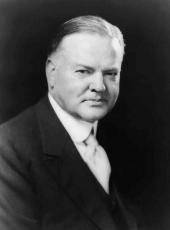LONDON NAVAL TREATY
THE PRESIDENT. I have nothing for publication today. I thought perhaps there are some details of the London agreement that you might like to know as background. The text will presumably be over on Tuesday-the full text.
The battleship arrangement for handling the scrapped ships will be actual scrapping. It developed that our three ships will be obsolete in 1931, less than a year from now, whereas the ships of the other countries would not be obsolete until 1934 or 1935, so they have arranged to scrap the whole group. One of each nation I believe is to be demilitarized and used for a training ship.
The aircraft carriers has one detail I have not seen in the press, and that is the 135,000 ton basis of the Washington Arms Treaty and the Japanese ratio to it, likewise the French and Italian ratios, are to include all aircraft carriers. There was either an intentional or unintentional lapse in the Washington Arms Treaty by which aircraft carriers of less than 10,000 tons apparently did not count in the tonnage, and some of the countries have either designed or intend to build some craft of under 10,000 tons, so that they will be all brought in under the limitations of the Washington Arms Treaty no matter what their size.
It is my understanding that the battleship and aircraft carriers paragraph, together with the submarines provision, and the definition of the various categories, which is rather an elaborate definition, will comprise the five-power portion of the treaty. The subsidiary limitations will be covered only by the three powers.
The submarine provision makes a very positive series of provisions for safety of passengers--that putting passengers in small boats unless a ship happens to be close to shore, in smooth waters, and various other definitions of that kind, will not do. There must be positive provisions for passengers' safety under submarine attack.
On the subsidiary tonnage, it is my understanding that the first seven of the cruisers of our new program will be laid down at any time that suits us. The next 3--that is, making up the total of 18--are to be laid down in 1933, 1934, and 1935. Under the provisions for commencing construction, it is open to the judgment of any power as to what they should construct, and all others individual have the right without consultation to build up to those ratios. I say that because there seems to be some delusion that it is the result of consultation and determination. It is automatic.
Those, I think, are the only points that I have not seen fully covered in the press.
Q. Mr. President, you mean that the French and the Italians will sign the treaty, the one armament treaty, but subscribe only to the parts that relate to battleships ? Will that be all in one treaty ?
THE PRESIDENT. All in one treaty--battleships, aircraft carriers, submarine paragraphs, and the definition of categories. There are rather elaborate definitions in the treaty of the noncombatant craft which has been necessary, and they are being defined with certain sizes of guns and certain slow speeds, in order to cover such things as Yangtze River activities.
Q. Does that reference about the safety clause mean that some nations are not bound to build the same type as the other nations, Mr. President ?
THE PRESIDENT. Oh, no. While any nation can determine for itself, it is my understanding, what type it will build beyond the limits of the treaty, every other nation may adopt the same types if she wishes.
Q. Is there any provision made for the destroyers that the Coast Guard took over?
THE PRESIDENT. In the category of definitions, there is a provision covering that type of ship, that have been put to what you might call civilian ships--certain provisions to assure they are noncombatant ships. And that is all I have.
Q. Mr. President, when would the last of the 18 cruisers be laid down ?
THE PRESIDENT. 1933, 1934, and 1935.
Q. Mr. President, will you have any more preliminary conferences before the delegates arrive back in Washington ?
THE PRESIDENT. I don't think so. We can handle the situation very well. There has been no decision as to when it will be sent to the Senate until the delegation returns.
Q. Mr. President, about those scrapped battleships--you said one of those battleships will be transferred into a transport or training ship ?
THE PRESIDENT. Training ship. I don't want to be too positive. There is some discussion about it. It is not settled, but it is for purely training purposes. They are demilitarized ships. The Japanese have asked to have one of their ships set aside for training purposes. There is no objection to that.
Q. Mr. President, is this all background information ?
THE PRESIDENT. Yes.
Note: President Hoover's one hundred and fourth news conference was held in the White House at 4 p.m. on Friday, April 18, 1930.
Herbert Hoover, The President's News Conference Online by Gerhard Peters and John T. Woolley, The American Presidency Project https://www.presidency.ucsb.edu/node/210788


